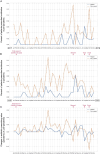Three-year impact of COVID-19 pandemic on hospitalized twin pregnancies: evaluation of characteristics and changes in antibiotic prescribing
- PMID: 40606471
- PMCID: PMC12213898
- DOI: 10.3389/fmed.2025.1546013
Three-year impact of COVID-19 pandemic on hospitalized twin pregnancies: evaluation of characteristics and changes in antibiotic prescribing
Abstract
Background: The COVID-19 pandemic has significantly impacted healthcare systems worldwide, including obstetric care. However, the long-term effects on twin pregnancies remain unclear. This study investigates the impact of COVID-19 on the clinical characteristics and antibiotic prescribing patterns in hospitalized twin pregnancies.
Methods: A retrospective cohort study was conducted at Women and Children's Hospital of Chongqing Medical University, Chongqing, China, involving 3,827 twin pregnancies with live deliveries between 1 January 2017 and 31 December 2022. The pre-pandemic group included 1,707 patients, and the pandemic group included 2,120. Sociodemographic and clinical data were analyzed using general linear models with SPSS and R software.
Results: During the pandemic, twin pregnancy admissions increased by 24.19%. Patients in the pandemic group have less gestational weight gain (17.00 vs. 16.08 kg, P < 0.001), had higher rates of assisted reproductive technology use (73.2% vs. 68.7%, P = 0.002), and experienced more complications. Neonates showed higher rates of pneumonia (5.7% vs. 3.8%, P < 0.001) and NICU admissions (43.7% vs. 13.9%, P < 0.001). Longer hospital stays were observed in the pandemic group (P = 0.004). Antibiotic prescriptions, especially non-repeat prescriptions, increased for older patients, those with higher BMI, and premature deliveries. The rate of repeated antibiotic prescriptions for bacterial vaginosis increased 1.68 times.
Conclusion: COVID-19 influenced twin pregnancy admissions, clinical characteristics, and antibiotic use. The study highlights the need for rational antibiotic use and improved healthcare resource management in future crises.
Keywords: COVID-19 pandemic; antibiotic prescribing; clinical characteristics; retrospective cohort study; twin pregnancies.
Copyright © 2025 Cai, Liu, Zhi, Tang, Wang, Lan, Wen, Luo, Wang, Sheng and Liu.
Conflict of interest statement
The authors declare that the research was conducted in the absence of any commercial or financial relationships that could be construed as a potential conflict of interest.
Figures





Similar articles
-
Delayed antibiotics for symptoms and complications of respiratory infections.Cochrane Database Syst Rev. 2004 Oct 18;(4):CD004417. doi: 10.1002/14651858.CD004417.pub2. Cochrane Database Syst Rev. 2004. Update in: Cochrane Database Syst Rev. 2007 Jul 18;(3):CD004417. doi: 10.1002/14651858.CD004417.pub3. PMID: 15495108 Updated.
-
Gestational weight gain below instead of within the guidelines per class of maternal obesity: a systematic review and meta-analysis of obstetrical and neonatal outcomes.Am J Obstet Gynecol MFM. 2022 Sep;4(5):100682. doi: 10.1016/j.ajogmf.2022.100682. Epub 2022 Jun 18. Am J Obstet Gynecol MFM. 2022. PMID: 35728780
-
Interventions to improve antibiotic prescribing practices for hospital inpatients.Cochrane Database Syst Rev. 2017 Feb 9;2(2):CD003543. doi: 10.1002/14651858.CD003543.pub4. Cochrane Database Syst Rev. 2017. PMID: 28178770 Free PMC article.
-
The clinical characteristics differences between IVF twins and naturally conceived twins with preterm infants.Medicine (Baltimore). 2025 Mar 21;104(12):e41884. doi: 10.1097/MD.0000000000041884. Medicine (Baltimore). 2025. PMID: 40128014 Free PMC article.
-
Perinatal outcomes of twin pregnancies in women with a unicornuate uterus.Arch Gynecol Obstet. 2025 Jul;312(1):229-236. doi: 10.1007/s00404-025-08001-x. Epub 2025 Mar 21. Arch Gynecol Obstet. 2025. PMID: 40119210 Free PMC article.
References
-
- Buch-Vicente B, Acosta-Rodriguez JM, Sanchez-Sanchez ME, González-García N, Garcia-Ullan L, de la Iglesia-Larrad JI, et al. Coping strategies used by health-care workers during the SARS-COV2 crisis. A real-world analysis. Psychiatry Res. (2022) 317:114915. 10.1016/j.psychres.2022.114915 - DOI - PMC - PubMed
LinkOut - more resources
Full Text Sources

